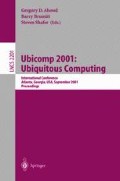Abstract
This paper introduces the Everywhere Displays projector, a device that uses a rotating mirror to steer the light from an LCD/DLP projector onto different surfaces of an environment. Issues of brightness, oblique projection distortion, focus, obstruction, and display resolution are examined. Solutions to some of these problems are described, together with a plan to use a video camera to allow device-free interaction with the projected images. The ED-projector is a practical way to create ubiquitous graphical interfaces to access computational power and networked data. In particular, it is envisioned as an alternative to the carrying of laptops and to the installation of displays in furniture, objects, and walls. In addition, the use of ED-projectors to augment reality without the use of goggles is examined and illustrated with examples.
Access this chapter
Tax calculation will be finalised at checkout
Purchases are for personal use only
Preview
Unable to display preview. Download preview PDF.
References
Weiser, M.: The Computer for the Twenty-First Century. Scientific American (1991) 94–100
Hoffman, D.:Visual Intelligence: How We Create What We See. W. W. Norton. (1998).
Raskar, R.: Oblique Projector Rendering on Planar Surfaces for a Tracked User. In: Proc. of SIGGRAPH'99. Los Angeles, California (1999) 260
Pinhanez, C., Nielsen, F., and Binsted, K.: Projecting Computer Graphics on Moving Surfaces: A Simple Calibration and Tracking Method. In: Proc. of SIGGRAPH'99. Los Angeles, California (1999)
Yang, R. and Welch, G.: Automatic and Continuous Projector Display Surface Calibration Using Every-Day Imagery. In: Proc. of 9th International Conf. in Central Europe in Computer Graphics, Visualization, and Computer Vision. Plzen, Czech Republic (2001)
Faugeras, O.:Three-Dimensional Computer Vision: A Geometric Viewpoint. The MIT Press. Cambridge, Massachusetts. (1993).
Wren, C., Azarbayejani, A., Darrell, T., and Pentland, A.: Pfinder: Real-Time Tracking of the Human Body. IEEE Trans. Pattern Analysis and Machine Intelligence 19(7) (1997) 780–785
Brumitt, B., Meyers, B., Krumm, J., Kern, A., and Shafer, S.: EasyLiving: Technologies for Intelligent Environments. In: Proc. of 2nd International Symposium on Handheld and Ubiquitous Computing (2000) 12–27
Rekimoto, J.: A Multiple Device Approach for Supporting Whiteboard-based Interactions. In: Proc. of CHI'98. Los Angeles, CA, April 18–23 (1998) 344–351
Underkoffler, J., Ullmer, B., and Ishii, H.: Emancipated Pixels: Real-World Graphics in the Luminous Room. In: Proc. of SIGGRAPH'99. Los Angeles, CA, August 8–13 (1999) 385–392
Krueger, M. W.:Artificial Reality II. Addison-Wesley. (1990).
Inami, M., Kawakami, N., Sekiguchi, D., Yanagida, Y., Maeda, T., Tachi, S., and Mabuchi, K.: Head-Mounted Projector for Projection of Virtual Environments on Ubiquitous Object-Oriented Retroreflective Screens in Real Environment. In: Proc. of SIGGRAPH'99. Los Angeles, California (1999) 245
Raskar, R., Welch, G., Cutts, M., Lake, A., and Stesin, L.: The Office of the Future: A Unified Approach to Image-Based Modeling and Spatially Immersive Displays. In: Proc. of SIGGRAPH'98. Orlando, Florida, July (1998) 179–188
Crowley, J. L., Coutaz, J., and Berard, F.: Things that See. Communications of the ACM 43(3) (2000) 54–64
Binsted, K., Morishima, S., Nielsen, F., Pinhanez, C., and Yotsukura, T.: HyperMask: Virtual Reactive Faces for Storytelling. In: Proc. of SIGGRAPH'99. Los Angeles, California (1999) 186
Ishii, H. and Ullmer, B.: Tangible Bits: Towards Seamless Interfaces between People, Bits, and Atoms. In: Proc. of CHI'97. Atlanta, Georgia, March (1997) 234–241
Author information
Authors and Affiliations
Editor information
Editors and Affiliations
Rights and permissions
Copyright information
© 2001 Springer-Verlag Berlin Heidelberg
About this paper
Cite this paper
Pinhanez, C. (2001). The Everywhere Displays Projector: A Device to Create Ubiquitous Graphical Interfaces. In: Abowd, G.D., Brumitt, B., Shafer, S. (eds) Ubicomp 2001: Ubiquitous Computing. UbiComp 2001. Lecture Notes in Computer Science, vol 2201. Springer, Berlin, Heidelberg. https://doi.org/10.1007/3-540-45427-6_27
Download citation
DOI: https://doi.org/10.1007/3-540-45427-6_27
Published:
Publisher Name: Springer, Berlin, Heidelberg
Print ISBN: 978-3-540-42614-1
Online ISBN: 978-3-540-45427-4
eBook Packages: Springer Book Archive

